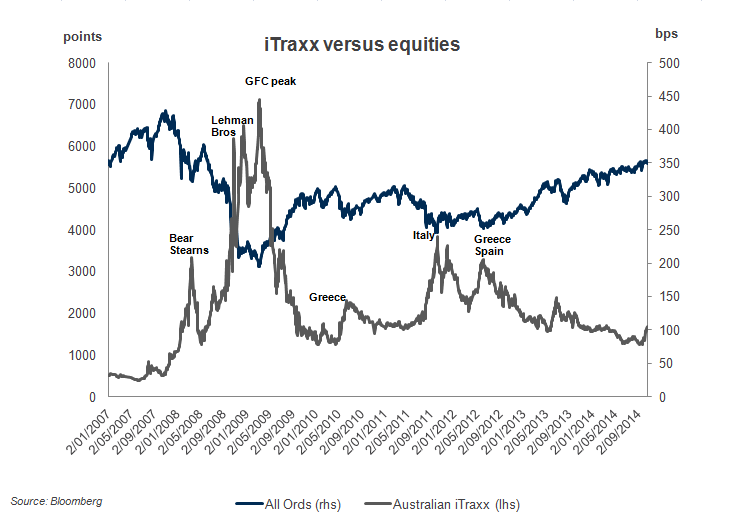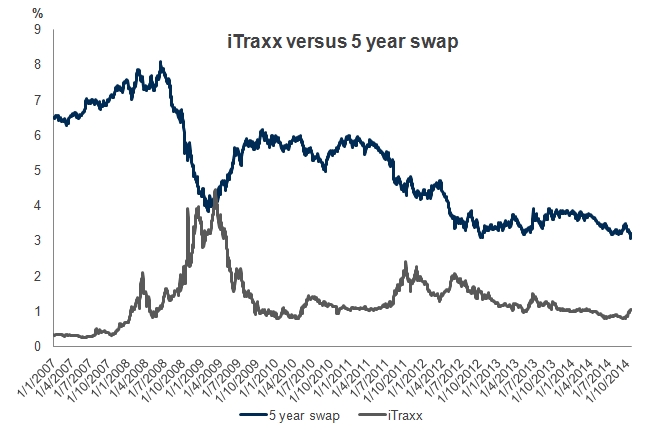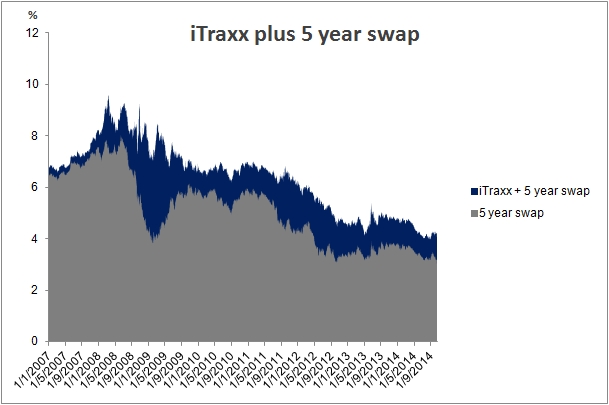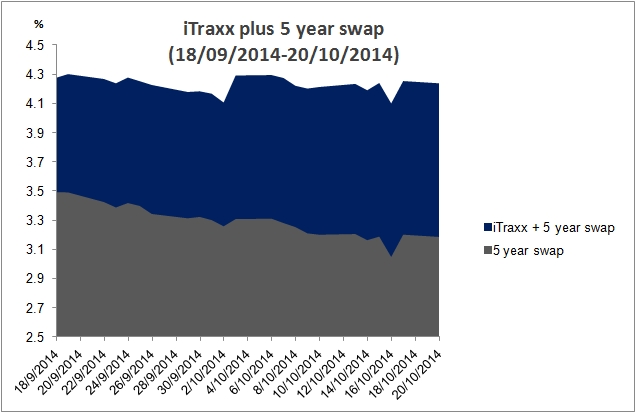The Aussie iTraxx is a “proxy” for credit spreads in the Australian market
What is the Aussie iTraxx?
We are often asked “what is the Aussie iTraxx and why should I care about it”?
The simple answer is the Aussie iTraxx is a “proxy” for credit spreads in the Australian market. It is an index, not unlike the ASX All Ordinaries Index for equities, which provides information on the direction and trend of the market.
The Aussie iTraxx is composed of five year credit default swaps (CDS) for the 25 most liquid and highly traded investment grade Australian entities in the market. Each of the 25 “entities” is given equal weighting and must meet the following requirements to be included:
The entity has to be listed on the Australian Stock Exchange (ASX) and have a five year CDS All entities must be investment grade by any of the three major rating agencies (S&P, Moody’s and Fitch) that rate them Market makers submit a list of the most liquid traded entities for the previous 12 months to the International Index Company (IIC). IIC then computes final liquidity ranking for each entity. The entities making the iTraxx are the top 25 as per the IIC final list. The list is refreshed every six months All constituents have equal weighting of no more than 4% No more than 5 banks can be included in the Index, thus comprising no more than 20% of the total weighting The “price” of the iTraxx is simply the weighted average basis point (bps) cost of the 25 CDS contracts with each individual CDS acting as a “proxy” for credit spread on that particular company. Typically speaking, CDS and the actual credit margin on cash bonds from the same company will move in a similar fashion. The weighted average of all 25 CDS contracts then acts as a “proxy” for the credit spread of the Australian investment grade credit (or corporate bond) market as a whole.
Importantly, it does not incorporate outright yields. That is, the movement in base interest rates such as the Government bond risk free rate, the RBA cash rate or the bank bill swap rate (BBSW). The Aussie iTraxx only looks at the credit spread component that is overlayed or added to the base interest rates or yield curve (see below for further details).
Why should I care about it?
Download the Deloitte Corporate Bond Report
It is a source of information. It is similar to the ASX All Ordinaries Index for equity investors. It shows movements and trends and enables bond investors to benchmark changes in their own bonds versus the broader market. It can also be used, together with other indices and information sources (such as equity indices, volatility (VIX), interest rates and yield curves) to gauge market sentiment and likely future direction.
While not available to individual investors (unless you want to place a $10m minimum position), the Aussie iTraxx is used by professional investors and fund managers to speculate on the direction of credit spreads and to protect (or insure) against losses. Naturally, the effectiveness of the protection depends on how well the Aussie iTraxx replicates the characteristics of the investor’s physical credit exposure. Professional investors are attracted by the very liquid nature and transparency in pricing.
How has the Aussie iTraxx performed and how does it move with equities and interest rates?
The following chart plots the Aussie iTraxx and the ASX All Ordinaries Index from January 2007 (i.e. pre-GFC) to date.

Figure 1
There are a number of important observations:
- Pre-GFC the index was consistently around 30bp. This indicates that the average five year credit spread (or cost of borrowing above the benchmark rate such as bank bill swap rate or BBSW) for investment grade issuers in Australia was around 30bp. A margin that most pundits would freely suggest was way too low.
- In the midst of the GFC when the risk of a banking system collapse was very real and equity markets hit their nadir (in March 2009), the Aussie iTraxx reached a peak of 443bps. This time a margin that was clearly too high.
- After March 2009 spreads rapidly improved in line with equity markets and settled around 100bp until Greece and the other PIIGS (Portugal, Italy, Ireland, Greece and Spain) raised concerns around European sovereign (and bank) debt levels. Equities again sold off and global credit spreads rose. The Aussie iTraxx followed suit and was characterised by the “risk on” and “risk off” periods that existed for some 18 months
- Finally, with the market becoming comfortable around European sovereign debt and US growth, equities again rallied and the Aussie iTraxx tightened to touch a low of 78bps on 18 September 2014. However, the selloff in Global and Australian equities that started in September 2014 has resulted in the Aussie iTraxx retracing to 105bps.
A clear trend that should have emerged from reading the above is the inverse correlation between credit spreads (as measured by the Aussie iTraxx) and global equities. When equities are falling, credit spreads are increasing and intuitively this makes sense.
There is also a negative correlation between interest rates or more correctly yield curves and the Aussie iTraxx (representing credit spreads). When equities are falling and credit spreads are widening (typically in times of low growth and/or risk aversion), outright yields or interest rates are falling as the central bank lowers interest rates in an attempt to improve growth. This is not always the case but is a relatively useful rule of thumb.
The chart below plots the Aussie iTraxx and the Australian five year swap rate. Again the inverse relationship is clear to see.

Source: Bloomberg
Figure 2
If we add the two together, as shown in figure 3 below, we get a proxy for the yield to maturity on five year investment grade corporate bonds in Australia. Note how the two tend to offset each other, particularly in times of significant volatility or movement.

Source: Bloomberg
Figure 3
This inverse correlation and the smoothing effect is demonstrated in the final chart (figure 4 below) which highlights the relationship since 18 September 2014, where global growth concerns, Ebola and heightened geopolitical risks have seen equities fall, credit spreads rise 27bps (Aussie iTraxx out from 78bps to 105bps) and the five year swap rate fall 31bps (from 3.49% to 3.18%). Adding the two together, the total change in our proxy for yield to maturity has been a 4bps decline despite a significant movement wider in credit spreads, protecting the value of fixed rate bonds.

Source: Bloomberg
Note: y-axis commences at 2.5% to magnify the impact of the change in the 5 year swap and the credit spread (i.e. Aussie iTraxx)
Figure 4
It is important to remember that when fixed rate yields (i.e. the total of the benchmark rate plus credit spread) fall, the price of fixed rate bonds increases. This is a crucial concept to investing and a powerful strategy for protecting your portfolio against falling equity values and even credit exposures.
Many investors would have seen that the increase in credit spreads on their bonds over the month has been more than offset by the fall in base yields for fixed rate bonds such that the price has remained unchanged or even risen. However, floating rate notes (FRNs) have not seen the price improvement from falling yields but have felt the negative effect of rising credit spreads.
When the opposite is true and the economy is in a “boom” cycle, credit spreads are typically tightening. For fixed rate bonds the benefit of tighter credit spreads can be offset by rising yields (as cash rates are raised to combat inflation). FRNs in this scenario would generally receive the benefit of both tighter credit spreads and a rising benchmark rate (typically BBSW, which follows movements in the cash rate closely).